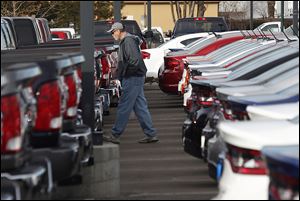
Subprime borrowing gains traction in the auto industry
11/11/2013
A buyer moves between rows of 2013 Ram pickup trucks and Dart sedans at a Dodge dealership in Littleton, Colo. Buyers with imperfect credit account for 27 percent of loans for new vehicles.
SOUTHFIELD, Mich. — Houston car dealer Alan Helfman served a woman in his showroom last month with a credit score lower than 500 and a desire for a new Dodge Dart for her daily commute. She drove away with a new car.
A year ago, with a credit ranking in the bottom eighth percentile, “I would’ve told her don’t even bother coming in,” said Mr. Helfman, who owns River Oaks Chrysler Dodge Jeep Ram, where sales rose about 20 percent this year. “But she had a good job, so I told her to bring a phone bill, a light bill, your last couple of paycheck stubs and bring me some down payment.”
As the fifth anniversary of the Federal Reserve’s policy of keeping interest rates near zero approaches, the market for subprime borrowing is once again becoming frothy, this time in the car business. As with mortgages in 2006 and 2007, the central bank’s stimulus is making it easier for people with spotty credit to buy cars as yield-starved investors purchase riskier bonds linked to auto loans.
While surging light-vehicle sales have been one of the bright spots in the U.S. economy, it’s increasingly being fueled by borrowers with imperfect credit. Such car buyers account for more than 27 percent of loans for new vehicles, the highest proportion since Experian Automotive started tracking the data in 2007. That compares with 25 percent last year and 18 percent in 2009, as lenders pulled back during the recession.
Issuance of bonds linked to subprime auto loans soared to $17.2 billion this year, more than double the amount sold during the same period in 2010, according to Harris Trifon, a debt analyst at Deutsche Bank AG. The market for such debt, which peaked at about $20 billion in 2005, was dwarfed by the record $1.2 trillion in mortgage bonds sold that year.
Shoddy home loans packaged into bonds by Wall Street banks fueled the financial crisis. Experience showed that vehicle loans are safer because the underlying asset can be more accurately valued, it’s easier to repossess, and people who need a car to get to work make that payment a priority.
“It’s a good investment” for lenders, Mr. Helfman said. “A person that has to get from point A to point B, they’re not going to jeopardize their job. They have to pay the car payment before they pay anything else.”
His Dodge Dart customer with the bad credit had to pay an above-average interest rate.
“It wasn’t pretty, but it wasn’t crazy,” he said. She was “so happy she couldn’t see straight.”
Fifty-eight percent of loans taken out to purchase Chrysler’s Dodge brand vehicles in October were with loans above the industry average of 4.2 percent annual percentage rate, according to Edmunds, a researcher that tracks vehicle sales.
The average loan for a Dodge charged an APR of 7.4 percent, and 23 percent of the loans had APRs of more than 10 percent, making it the brand with the highest percentage of loans for more than 10 percent, followed closely by Chrysler and Mitsubishi. Rates on subprime auto loans can climb to 19 percent, according to S&P.
Dodge U.S. sales rose 17 percent this year through October compared with a year earlier.